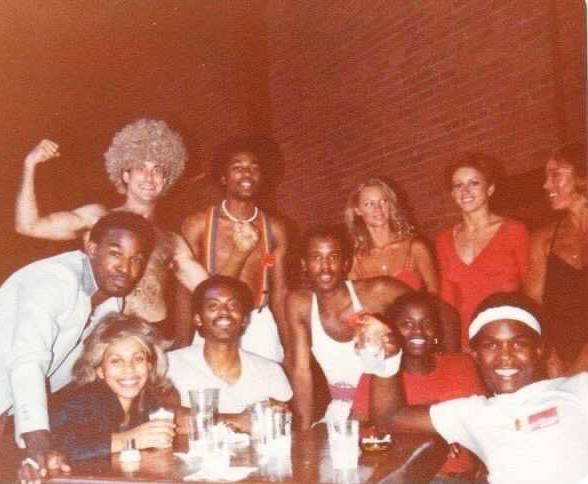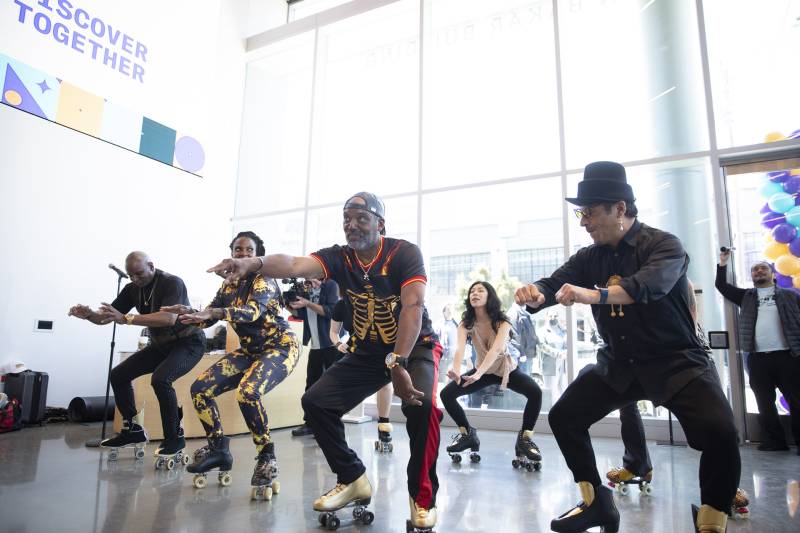This piece was originally a part of Rightnowish’s 2021 series, Roll With Us, all about the Bay Area’s community and culture on wheels.
Every Sunday San Francisco’s Richard Humphrey teaches roller dance classes in San Leandro; his students have the honor of learning from someone who has been on quad skates for five decades.
From 1979 to 1988, Richard was a part of the Golden Rollers, a trio of skaters who regularly performed in Golden Gate Park.
Since first getting his roll on, Richard has been featured in the television pilot, Dancing Wheels, was Damon Wayan’s skating stunt double in The Underground, performed on stage with Vaughan Mason, the creator of “Bounce, Rock, Skate, Roll,” and has been featured in Ebony Magazine. Richard has custom wheels that bear his name, and he has also worked with Riedell to manufacture a signature skating boot with no laces called, No Strings Attached.

By now, Richard has taught thousands of people his signature skating style of “roller dance” (even Dr. Oz) through in-person classes and video tutorials.
After noticing the rise of skating’s popularity during the COVID-19 pandemic, Richard wanted to make sure folks knew that skating has a deep-seated culture with a history that pre-dates the internet, and moves that sparkled on the rink long before most viral stars were born.
This week on Rightnowish, we roll into Memorial Day weekend– the unofficial start of summer– with the legendary Richard Humphrey.
Below are lightly edited excerpts of my conversation with Richard Humphrey.
Harshaw: How would you describe the scene when you first started skating?
Humphrey: What was so cool about the rink days, especially the late 70s, man, everybody’s passion was unbelievable. I mean, it was like the coolest thing in the whole world.
When we started skating together, we had all our big radios, our big boom boxes, we would put two or three of them together, wait for a song to come on the radio just so we could dance. And one of the coolest things – matter of fact, I still have one in my room today – it’s called the bone phone. You just put it right over your neck and it’s like a little sleeve and you can just listen to the radio, ya know, everybody can hear the bone phones. That was hot… So a lot of things happened in the 70s that just made skating what it is today. And it just kind of grew.
Harshaw: As an African-American person, how would you say that Black folks skate differently?
Humphrey: Ay, you know, we got that bounce, we got that swag, we got that rhythm. For a lot of us, man, we grew up with music and poppin’ our fingers and dancing and just having fun. The skates kind of gave it a different dimension, that’s all.
If you look at the history of roller skating we were excluded… when we finally were included… they gave us one night. One night of skating, which has pretty much been happening for the last 40, 50 years, almost even to this day! They don’t use the word “Black Night,” [more like] “Rhythm Night” or whatever. We got names associated with the night that we’re going to be there, all the other nights is just a regular night.
And even to this day, we still have issues when it comes to skating and being Black at rinks because… when we go into a rink, we are searched… they’re looking in our bags, they’re looking at our clothes. Such a turn off to go to a rink and say, OK, I need to stand up against the wall, [get] pat down like everybody’s a criminal. Oh, I hate that.
But what we did find out: we don’t really need a rink if we got a smooth surface or space. We got Bluetooth now, we don’t have to have a DJ. That’s what we do on Sundays. Regardless of whether they give us a night or not. We’ll make it happen
Harshaw: I was checking out your roller dance website, and there’s this one photo… it’s black and white it’s you and two other gentlemen. It looked like y’all were doing a Temptation-esque, in a diagonal formation striking a pose almost down in the splits — really low to the ground — with your arms stretched out… It looked like a performance. What was going on in this photo?
Humphrey: In that photo, we were called the Golden Rollers.
Back in the early part of ‘79, we didn’t have the wheels that absorb the shock that we do now. So 1979 became epic because the polyurethane wheel came out and once that soft wheel came out, rollerskating outdoors exploded! We all were into the splits cuz the splits back then was like the hottest move on roller skates. If you could do the splits, you bad.
For me, it was perfect because in high school, college, I was a hurdler, so I ran hurdles. That was my thing. So that particular move right there was straight up my alley. I mean, I could go all the way down, put my chin literally on my knee and come back up in like two moves: down, come back up, and rolling all at the same time.
That became like our signature pose, every time we ended our [performance], it was sort of like a thank you. So that move has just become iconic, I guess.
Harshaw: But there’s more to the art.. It’s not just the dance, as you mentioned before, it’s kind of the swag attitude and it’s also the fashion, that is a part of it. And I see that you have designed a pair of skates with no strings?
Humphrey: Ya know, I said to myself one day it would be the coolest thing in the world to have my own boot, something with my name on it. 2009, it actually happened. I was able to collaborate with Riedell Roller Skates, which is [one of] the biggest roller skate companies in the world. I brought them the idea and they said we’ve never done a boot with no laces! And I was like, OK, well, that’s good then, so let’s do our thing.
It’s authentic Richard Humphrey, “No Strings Attached.” And I came up with the no strings attached name because I was like, there’s no laces attached to it. So that was a cool, catchy name.
Roller skating is not like basketball where Curry and all these guys got all these big endorsements and all that kind of stuff. We don’t have that in roller skating. It is rare, absolutely rare for a huge skate company like Riedell or Sure-Grip or any other skate company to actually endorse a person and yet alone put their name on a boot.
Harshaw: Beautiful, hats off to the commitment.

Rightnowish is an arts and culture podcast produced at KQED. Listen to it wherever you get your podcasts or click the play button at the top of this page and subscribe to the show on NPR One, Spotify, Apple Podcasts, TuneIn, Stitcher or wherever you get your podcasts.


